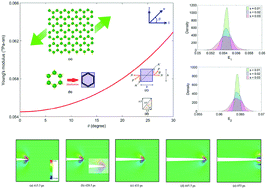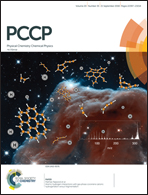Probing the chirality-dependent elastic properties and crack propagation behavior of single and bilayer stanene†
Abstract
Stanene, a quasi-two-dimensional honeycomb-like structure of tin belonging to the family of 2D-Xenes (X = Si, Ge, Sn) has recently been reported to show promising electronic, optical and mechanical properties. This paper investigates the elastic moduli and crack propagation behaviour of single layer and bilayer stanene based on molecular dynamics simulations, which have been performed using the Tersoff bond order potential (BOP). We have parameterized the interlayer van der Waals interactions for the bilayer Lennard-Jones potential in the case of bilayer stanene. Density functional calculations are performed to fit the Lennard-Jones parameters for the properties which are not available from the scientific literature. The effect of temperature and strain rate on the mechanical properties of stanene is investigated for both single layer and bilayer stanene in the armchair and zigzag directions. The results reveal that both the fracture strength and strain of stanene decrease with increasing temperature, while at higher loading rate, the material is found to exhibit higher fracture strength and strain. The effect of chirality on the elastic moduli of stanene is explained on the basis of a physics-based analytical approach, wherein the fundamental interaction between the shear modulus and Young's modulus is elucidated. To provide a realistic perspective, we have investigated the compound effect of uncertainty on the elastic moduli of stanene based on an efficient analytical approach. Large-scale Monte Carlo simulations are carried out considering different degrees of stochasticity. The in-depth results on mechanical properties presented in this article will further aid the adoption of stanene as a potential nano-electro-optical substitute with exciting features such as 2D topological insulating properties with a large bandgap, the capability to support enhanced thermoelectric performance, topological superconductivity and a quantum anomalous Hall effect at near-room-temperature.



 Please wait while we load your content...
Please wait while we load your content...